Earth Day is coming up this weekend on Sunday, April 22. Many treat it as a day similar to Arbor Day, going out & planting a little tree—which is, by all means, a great project and very valuable. But I wanted to present a project here that’s just a little different, and deals with something very important to all of us: WATER.
As I’ve mentioned here before, I’m part of a caving group (called a “grotto”) here in Missouri. My primary role with our grotto (when I can be bothered to stop taking photos):

…is collecting water samples & gauging the water quality of the streams & springs that connect to those caves. Water in a cave is a vital habitat and life source for so many critters that live in cave systems, like bats, crickets, salamanders, fish, as well as larger animals that can use these natural shelters as a den.

So it’s important to track the quality of the waters in these areas; if certain animals were to die off or abandon a cave, changes in the water quality data could indicate why this happened or where the change came from (polluted surface runoffs, over-fertilization, etc.)
We track parameters like hardness, pH, dissolved oxygen content, acidity, chlorine content, and microbe counts…but the type of tests we do aren’t just applicable to caves.
Anyone can test water quality with the right tools. You can test the water coming out of your faucet, or the water in the ditch outside your house, or the water in your pool, or (ick) even the water in your toilet, if you were so inclined. And most of the kids I know could stand to learn a thing or two about germs, bacteria, & pollution.
Micrology Labs sells a “Home Test Kit” for $8 that will give you all the supplies you need to run 5 water quality tests. There are three sets of “Coliscan” supplies that check for what my friend JoJo refers to as “bumbum germs” like E. Coli, and two sets of “Total Count” supplies that check for all the various types of bacteria (including the good kinds that are supposed to be in streams & ditches).
Your supplies will look like this:
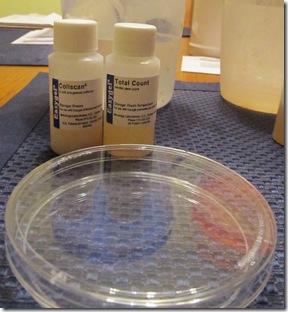 The petri dishes have been sterilized, so if you want accurate results, don’t let kids (or yourself) touch the insides of them.
The petri dishes have been sterilized, so if you want accurate results, don’t let kids (or yourself) touch the insides of them.
These are super easy to use.
Step 1: Collect water samples in a sterile container. I use heavy duty plastic containers with a screw top lid that have been through the dishwasher on the hot setting (no soap).
I collected my samples from a local cave that has two streams inside of it, that converge into one. We track these separately, so the samples were collected in the areas further back in the cave before the two streams meet up. The samples are collectively referred to as “East Passage” and “North Passage” in this post. The water in the East Passage comes from a spring, whereas the water in the North Passage comes from a surface stream and surface runoff north of the cave.
Step 2: Use the sterile syringe that comes with your kit to suction 1mL of water from your jar, and then add that 1mL of water each to the Coliscan and the Total Count bottles. These bottles contain liquid agar solution that will go into the petri dishes. You can reuse the syringe while you’re pulling water from the same water source (say, from your tap), but dispose of it before you move onto the next water source (ex. ditch water), and use a new sterile syringe for that water source.
Step 3: Put the cap back on the bottle & swirl the contents around for about 5 seconds, and then pour the contents of one of the bottles into a petri dish.
Probably a lot of you remember in school when the science teachers had petri dishes that already had the gummy-looking agar already inside the dish—and then you’d apply something to the top of that agar with a Q-Tip or pour something on top of it. However, by doing that, you might not get quite as accurate results, because the bacteria could just keep growing on top of the agar if it wanted to.
So by mixing the water with the liquid agar, the bacterial colonies will actually be embedded INSIDE the agar, and you won’t accidentally create a mutant bacterial colony prepared to take over your house.
Step 4: Now that it’s poured in, place the lid on top (being careful not to touch the inside), and then tape the lid on top, and write the name of the sample on the lid (Example: “Tap Water, Coliscan”) and the time & date.
Repeat for each of your water samples. In my case, I had four samples—two were from the East Passage, and two from the North Passage:
Step 5: Wait. It takes 48 hours for the colonies to mature in the agar. These can be stored at room temperature, so just put them somewhere out of the way for a while.
Step 6: After 48 hours, check your samples. You should see white specks in the Total Count Dishes, and in the Coliscan dishes, you should see mostly pink specks, and possibly some purple or the occasional blue or white speck:
Step 7: Count your bacteria colonies. Flip the containers over (the agar hardens after the first couple hours, so this is safe to do) so you can see the bacteria colonies without all your notes on top of them. Place on a colored background so their easier to see.
For Total Count, you’re interested in all of the white specks. If your samples have a LOT of white specks like the ones above, then draw an “X” across the bottom, equally dividing it into 4 sections—and then only count one section. Multiply that by 4, and you have your # of colonies per milliliter of water.
For the Coliscan, you’re only interested in the pink and the purple specks. Purple represents E. Coli (bad stuff), while the pink represents other types of coliforms (less bad, but still not great).
Step 8: Compare the numbers from your samples to each other. As you can see from my samples above, the water from the East Passage (which is spring-fed) contains much fewer bacteria colonies. The North Passage (which is fed from surface water) had about 3x as much bacteria, and even contained two E. Coli colonies.
In Missouri, the safe level for "whole body contact" (such as swimming) for E. Coli is 1.26 colonies per milliliter of water. For drinking water, the safe level of total coliforms (pink + blue) is ZERO. So we would not want to drink this water, obvs. (Thankfully, this is not where this area gets its drinking water from.)
If you’re doing a test on your tap water & you get any pink or white specks, you might want to call your local water company.
Water sources for different people come from different places. Here in our area, city water supply comes from surface water or deep water wells that have been circulated through a treatment plant before going to your house. It’s the water supplier’s duty to make sure that this water meets all “Safe Water” parameters before leaving its facility. Out in the country, some people have wells on their property that pulls from the groundwater directly, without any sort of treatment; if this is you, it would be a good idea to test your water once a year, just to make sure everything’s all good.
Step 9: Questions you can go through with your kids after the experiment:
1. How does our tap water compare to the water in the (ditch/toilet/creek/dog’s water bowl)?
2. For water samples collected outside: What are the possible pollution sources in your neighborhood that could have caused the results to be different from your tap water? (Farms=fertilizer, busy roads = runoff, litter in ditches, outside animals, chemical plants, gas stations, etc.)
3. For water samples collected indoors: What are the germ sources that could have caused the results to be different from your tap water? (Dog’s water bowl = doggie slobbers, Toilet = duh, etc.)
4. How can we help to make the water quality better, both inside and outside? (Picking up litter, not littering ourselves, contacting the Dept. of Natural Resources if high results are found, cleaning out the toilet/using chlorine tabs more often, replacing/washing the dog’s bowl more often, etc.)
5. How can we protect ourselves from polluted water? (Washing hands regularly, using hand sanitizer, not playing in ditches, not drinking water from ditches or creeks, etc.)
6. For outside water: what are some of the signs that water quality might not be good in an area? (Non-moving, stagnant water, dead or distressed plants along the banks, dead animals, or no animals, containers/debris that shouldn’t be there (buckets, barrels, drums, etc.), litter, unusual odors, rainbow sheens on the surface, areas of foam on the surface, water that isn’t clear or shallow water that is hard to see through, etc.)
There’s also a great area for kids on the Environmental Protection Agency’s (EPA) website that has more questions and experiments you can do with your kids. Activities are divided up by age level: http://water.epa.gov/learn/kids/drinkingwater/index.cfm
Step 10: KILL THOSE MICROBES! This is very important. Just because the colonies are contained doesn’t mean the petri dishes are safe to just throw away. Before you toss them in the trash, do one of these options:
- Place dishes and Coliscan bottles in a pressure cooker and cook at 15 lbs. for 15 minutes. This is the best method.
- Place dishes and Coliscan bottles in an ovenproof bag, seal it, and heat in an oven at 300° F for 45 minutes.
- Places dishes and Coliscan bottles in a large pan, cover with water and boil for 45 minutes.
- Place 5 ml (about 1 teaspoon) of straight bleach onto the surface of the medium of each plate. Allow to sit at least 5 minutes. Place in a watertight bag and discard in trash.

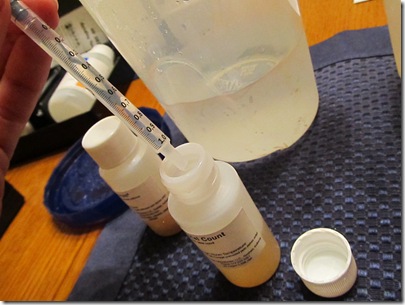
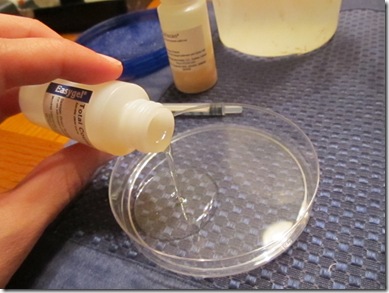
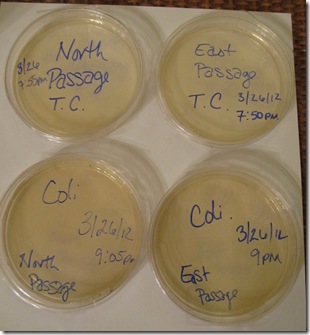
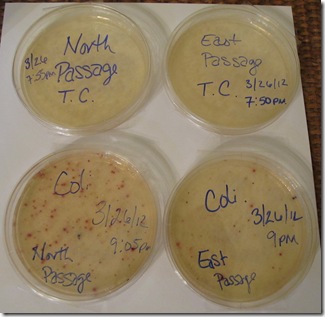
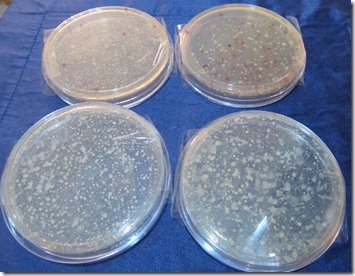
Ewww I am too scared to run a Coliscan test on my water. :D
ReplyDeleteIn the same way I'm too scared to bring a blacklight into a hotel room.
I think of all the homes in the US, yours would pass with flying colors. :D
Delete